
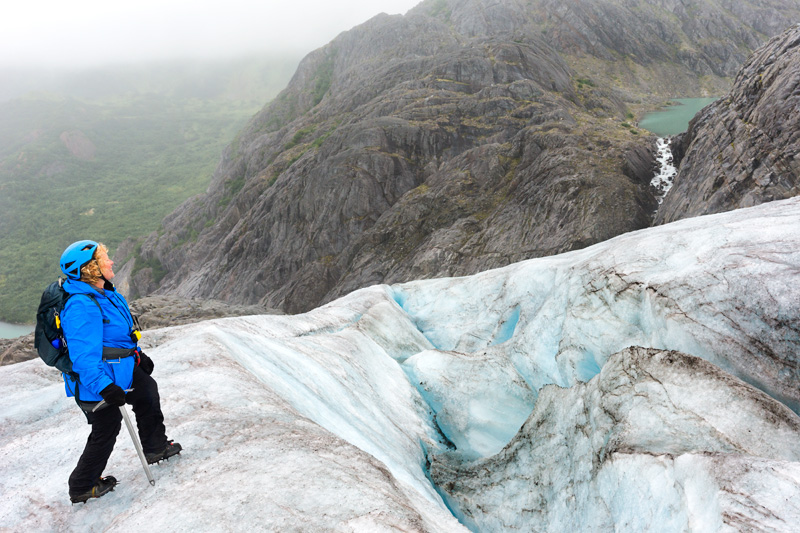
My sister and I joined a small group on an overnight glacier trekking adventure in southeastern Alaska in early August. The tour was organized through ABAK (Above & Beyond Alaska) and was lead by two fantastic guides, Samuel and Jacob. This is part two (in case you missed it, you can read Part 1 here.) We were 5 miles from Juneau, up high in the mountainous Tongass National Forest in the Juneau Icefield.
Day 2 of our Glacier Trekking Adventure:
“Hey, you awake?” I nudged my sister who was still cocooned in her bag at 7:30 am. I was excited for another day to explore Lemon Glacier. The night had been a little chilly due to the elevation and howling wind, but once we put on extra fleece layers, gloves and hats around 2 am, we fell fast asleep. ABAK had included everything for this overnight from the tent, zero degree sleeping bags, padded mattresses and even pillows. Comfy!

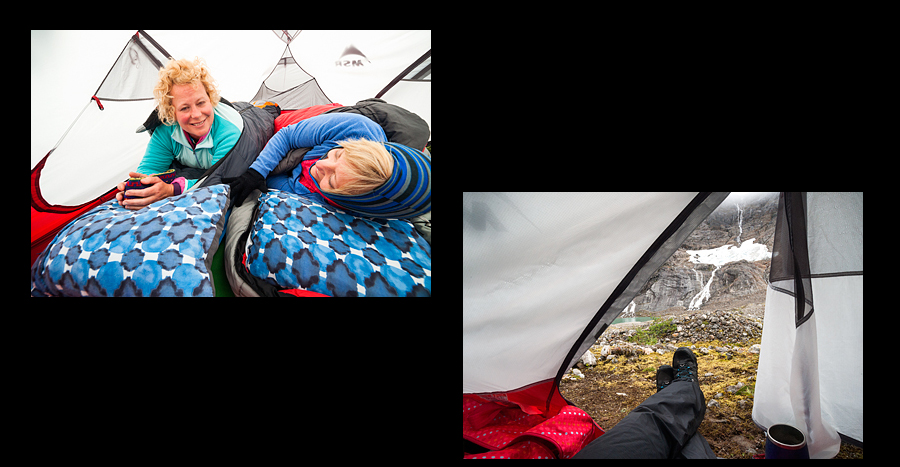
And the guides even set up our tents so we all had a room with a view…simply open the flap… and a giant waterfall appeared. What a great start to the day!
Peeking out, I saw that the young couple in our group were already up and raring to go.

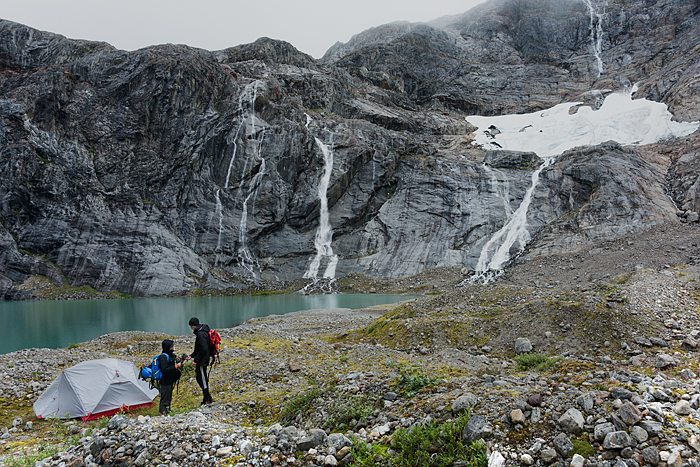
So we quickly made our way to the dining tent where Sam was already preparing coffee and breakfast burritos.

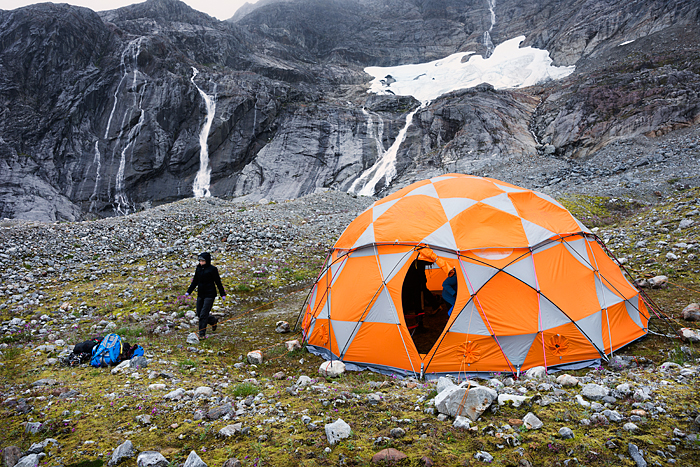
The guides took down our tents while we loaded up our gear so that we could spend the rest of the day exploring the glacier and not rush back to clean up. The helicopter would be arriving around 4 pm to take us back to Juneau.

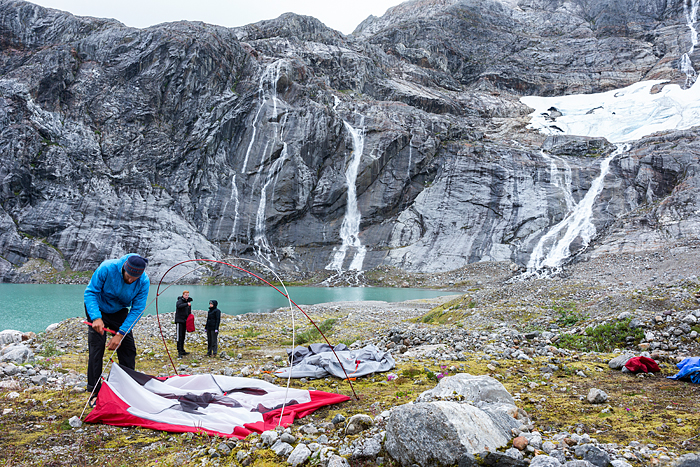
Soon we were ready to head out. Our group included 2 guides and 6 participants, Connor and Mara, a young couple from California, Patricia and John, a retired couple from Ohio, and my sister and I from the Midwest. There were 50 years between our ages but we shared a common zest for the great outdoors and a natural curiosity about what we would find in this icy wilderness. Even if that meant stepping outside our comfort zone at times, challenging ourselves mentally and physically in difficult terrain. We were all up for the adventure!
Heading to the Ice
Pat had a twinkle in her eye as we gathered with our backpacks. “Pinch me!” she said. “I can’t believe I’m here!” Exactly. We shared her enthusiasm. The glacier was new for our guides too, who normally lead day tours to Mendenhall Glacier. Only AKAK has exclusive permits to take groups to Lemon Glacier and we were the first group to stay overnight. It was pretty special.

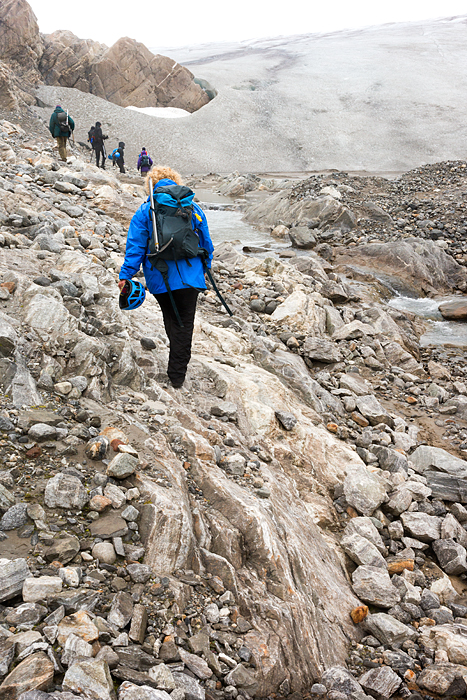
A light drizzle fell on us as we left base camp. We hiked past giant boulders, up over rocky moraine, crossed a stream, and twenty minutes later arrived at the edge of the ice. This time no one needed assistance attaching crampons to their boots. With our helmets, harnesses, and crampons on, we were ready to go!

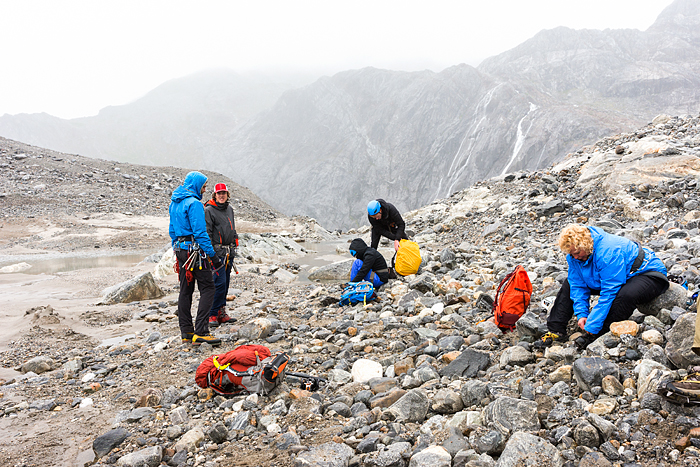
Jacob attached his crampons standing on the edge of the ice that meets the rocky moraine. If you think that the ice looks dirty and brownish here, that’s because it is. As the glacier moves under pressure from the weight of hundreds-of-years compressed snow-packed ice, it carries debris from crushed rocks, dirt and sand as it slowly flows over rocks and down the mountain slope.

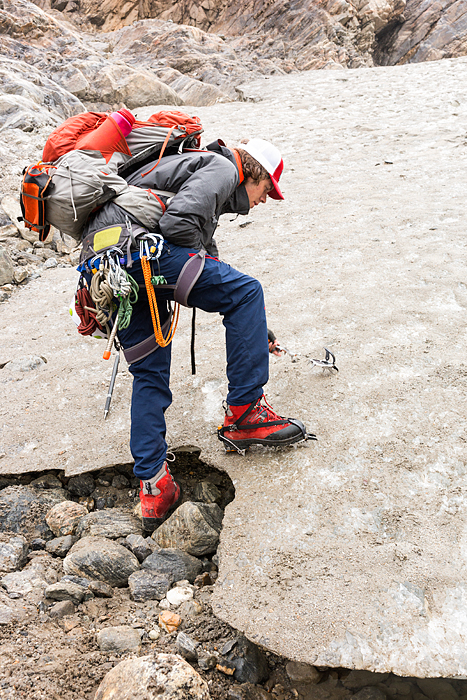
The dirtiest looking ice is found at the edge of a glacier—-wherever it meets rocks or mountain ridges.

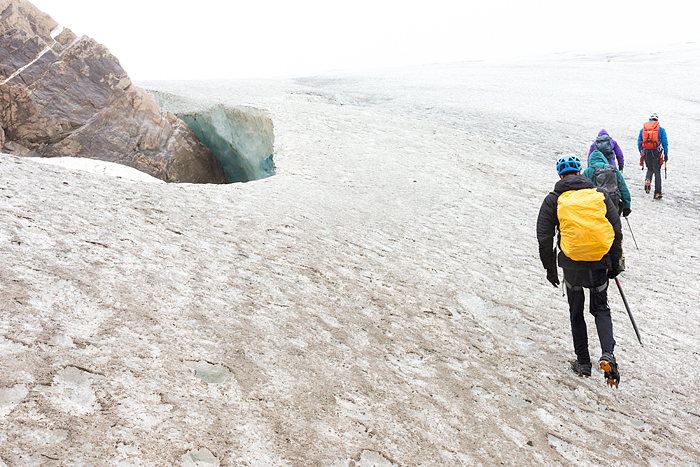
But the ice doesn’t stay dirty or featureless for long. Once we reached the top of Lemon Glacier, the surface was white with streaks of black-tinged ice. And instead of being flat, it was marked by holes, cracks, dips, scallops, ridges and fascinating formations known as moulins and crevasses.
Exploring Glacial Moulins and Crevasses

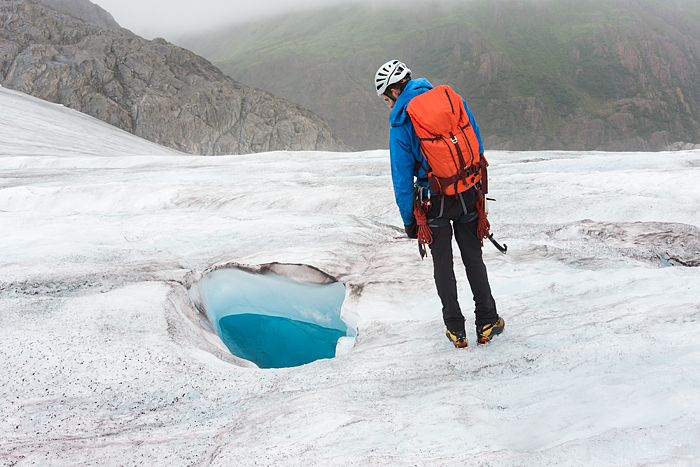
Our lead guide, Sam, pauses to look into a strange hole known as a moulin, a vertical ice shaft that drops straight down to the bedrock below. It could be hundreds of feet deep, who knows?
These mysterious holes start out innocently enough. A little water—from rain or melting snow—trickles into a crack in the flat surface of the glacier. But a moulin can form quickly and widen dramatically like a cathedral underground or remain vertical with twisted sculpted ice formations. As water accumulates it gains momentum and creates a turbulent river, pushing and forcing and eroding its way to the bottom of the bedrock. This river rushing along the very bottom helps the ice glide over the mountain, and affects how fast the glacier flows. Who knew that little hole held such power.
That moulin looked so intriguing… I would love to climb down to see what’s inside. There are some mountaineers that have done so and have captured some amazing images. But we weren’t doing anything that dangerous or extreme. If you stumbled and fell into one, you could easily fall 30 stories and plummet through a freezing waterfall or get wedged on a sharp pointy piece part way down. Either way…not good. Glad we had our expert guides!

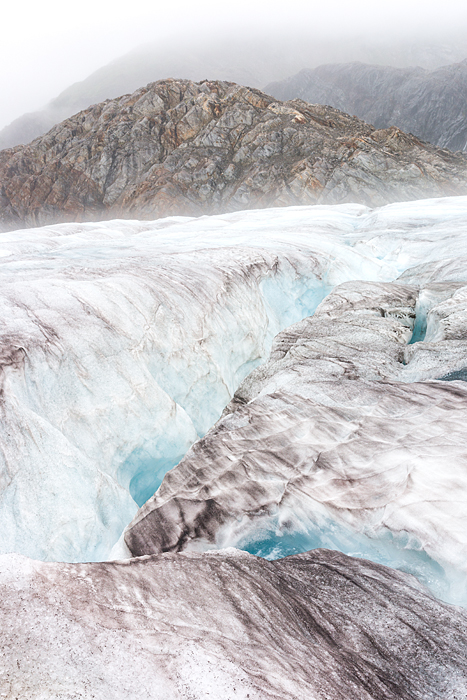
The black powdery silt left behind as lines and striations in the ice show the direction of the glacier’s movement. How boring it would look to be perfectly white. The dark lines also help show the texture and depth of the steep walls in the crevasses. Here is a close up of water rushing through a moulin.

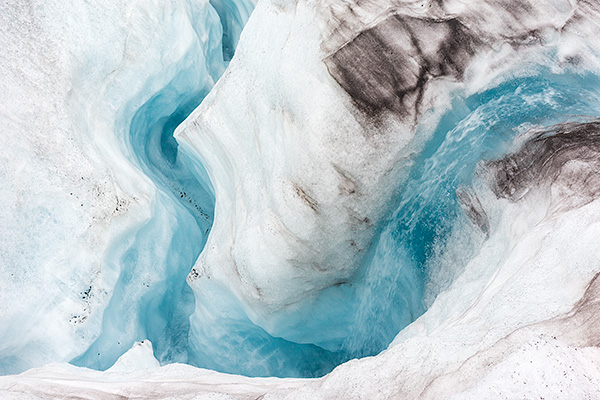

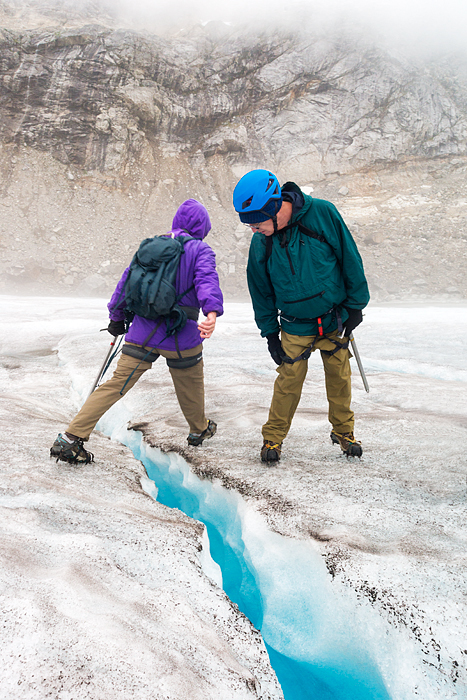
We never tired of peeking into the cracks or over the edge to the see what was below. Our guides were always ready to secure us in place by holding our harnesses.

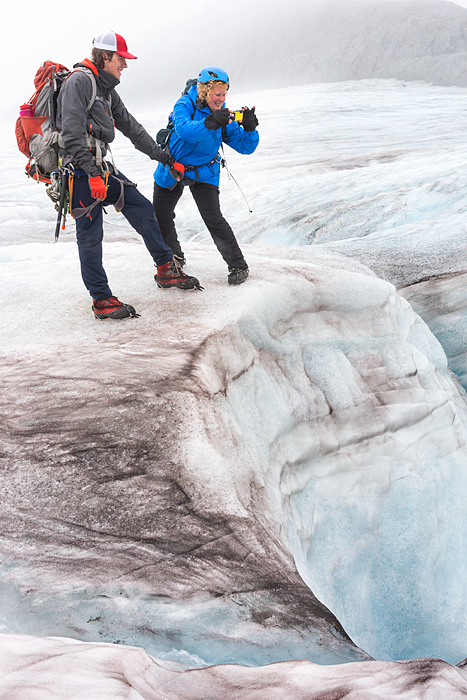

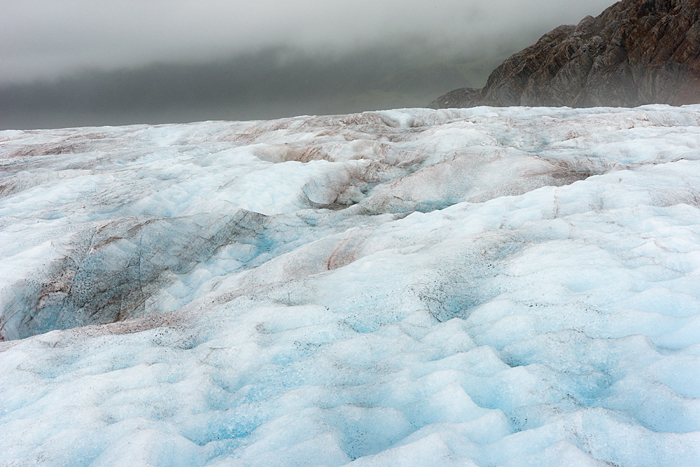
As we followed our guides toward the terminus of the glacier–the lower base where it ends–the surface turned even more dramatic. We approached an arresting but compelling pattern of repeating crevasses. Oh. Wow. We stopped in our tracks and just stared.

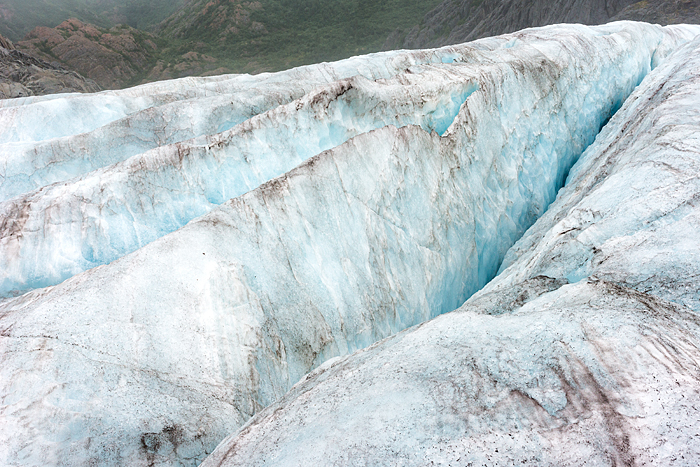
So spellbinding to see in person. Danger and intrigue seeped from those giant cracks—just steps away. Makes you instantly want to know—how does the ice do that? A crevasse forms when ice cracks under pressure from extensive stress within the ice. This usually happens when a flowing glacier moves very rapidly and stretches the icy surface during transit. Although there are different types, these crevasses were known as the Transverse Form, as they fanned across the glacier perpendicular to the flow. The depth looked frightening, yet crevasses are shallower than moulins. They form in the brittle top 160 feet of a glacier, and never reach the bedrock far below.
So if a series of crevasses fan out along the surface, how do you get around them? Well, you jump! Only the narrow ones, that is. And even those were aided by our guides who assisted us on either side. Safety first. Thrilling adrenaline, a close second.
Crossing Crevasses…oh my!


Summer is the best time to explore glaciers to reduce the danger of falling into a crevasse or moulin. This is because they are visible in the ablation zone (glacial area that has a loss of mass from melting snow or ice), and not hidden under snow. Ablation zones are where commercial tour operators send groups for glacial trekking. (Moulins and crevasses higher up the mountain in the accumulation zone of deep snow will still remain hidden crevasses in summer months, making trekking dangerous and only appropriate for experienced mountaineers who rope together for safety.)

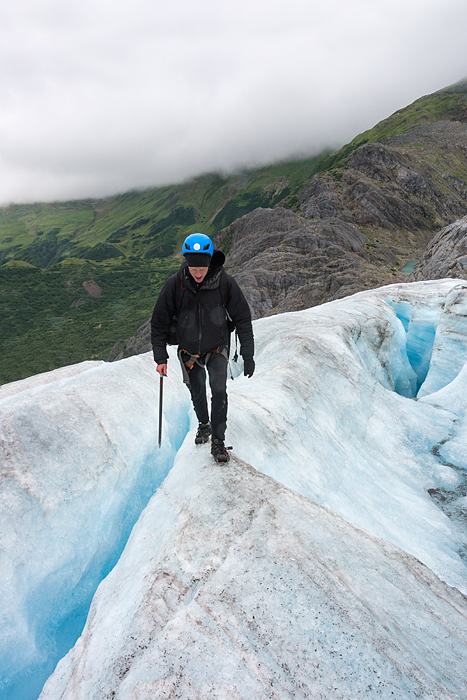
It felt a little scary, but our confidence grew as we walked along the narrow path between crevasses, hearing the crunch of our steel-spiked crampons dig securely into the icy ridge.

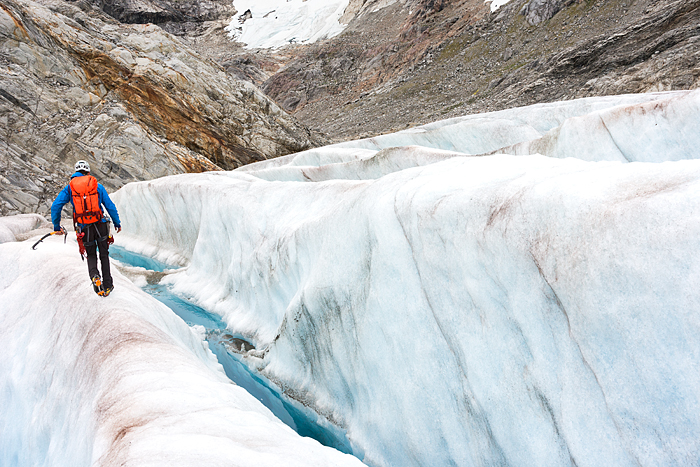
Today was Jacob’s birthday. And what a perfect day to play. His favorite way to celebrate? Ice climbing and exploring. Yay!

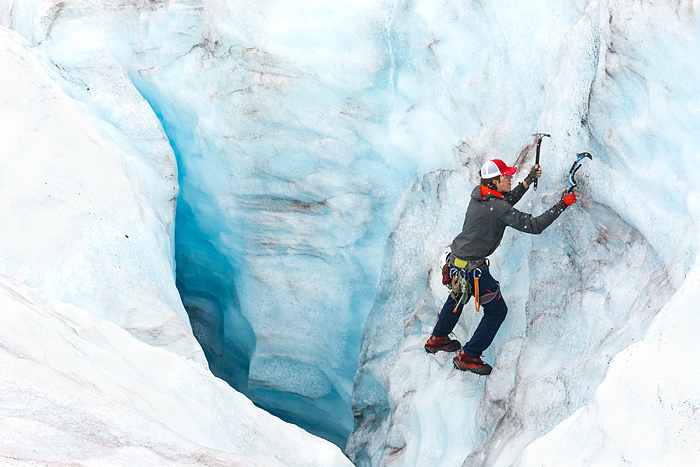
Reaching the angled slope descending toward the terminus, my sister paused to look across at a glacial pond, or tarn, cradled in the adjacent mountain.

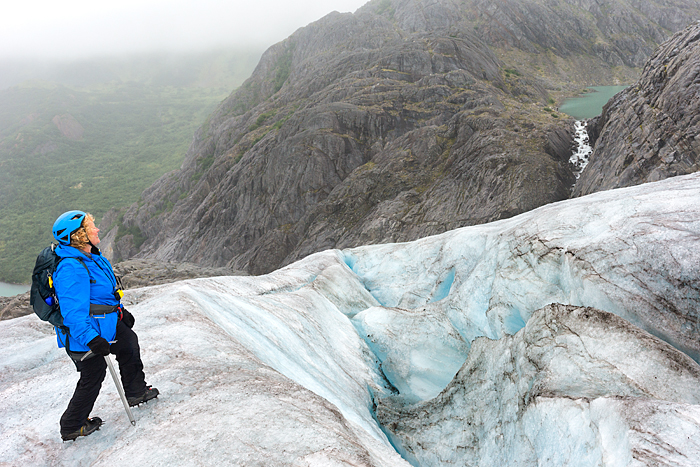
The guides moved ahead to consult privately. Should we keep our group together or separate? Should we attempt to head down to the terminus?

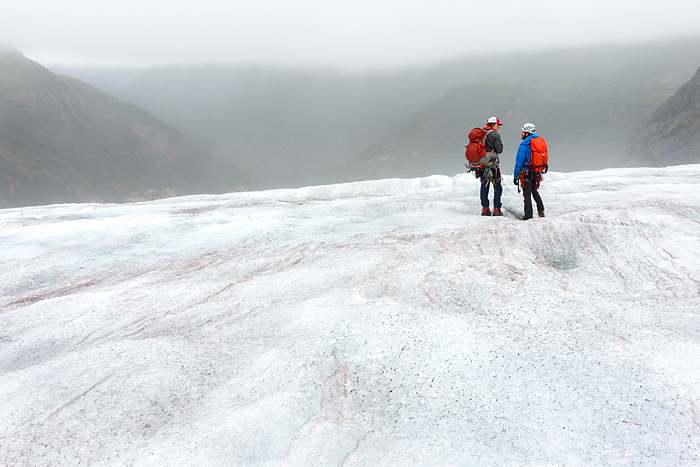
They came back and told us to follow them.

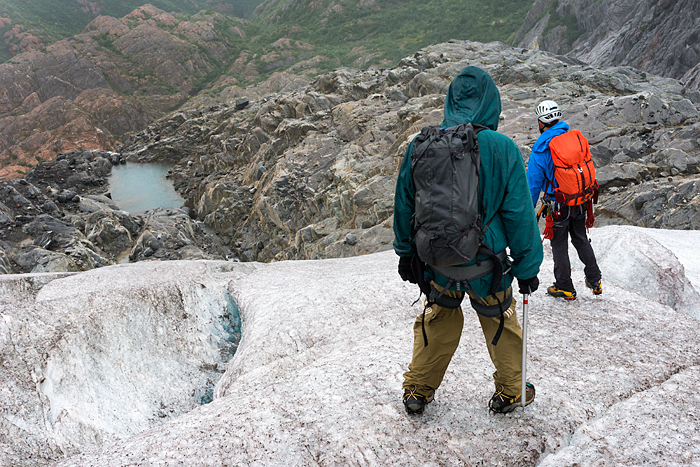
Rappelling down the Glacier
We hiked across the ice and came to the edge of a slope where we could see the terminus and rocky base of the glacier. That’s where we were headed. The steep descent looked dicey. And was. The first chap to follow the guide down took a fall, even though he correctly assumed the cowboy slouch and forcefully dug his heels in, one step at a time. The slope was simply too icy.

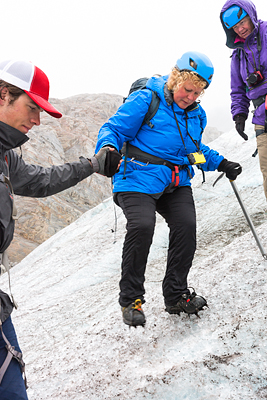
So Sam quickly intervened. He screwed a metal ring into the ice so we could attach ropes to our harnesses and rappel down.

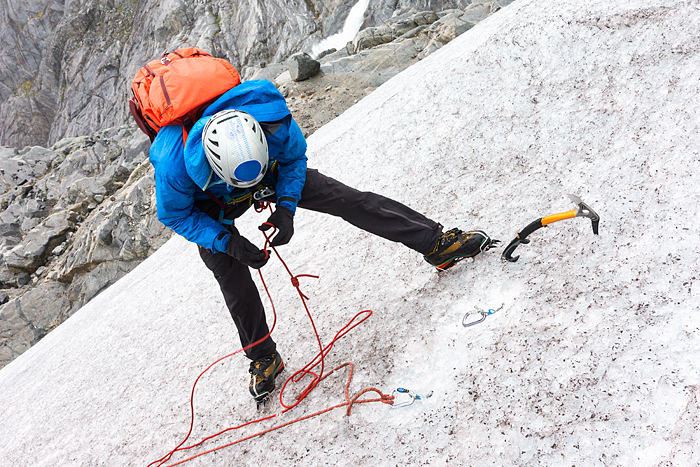
And down we went…

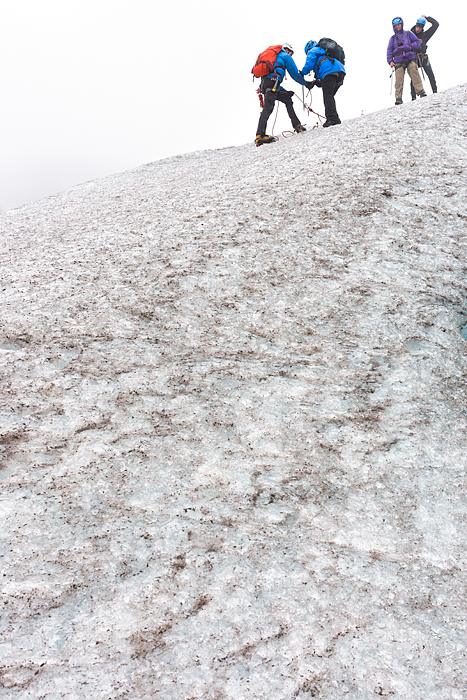
Even with the security of the rope, the slope was slippery.

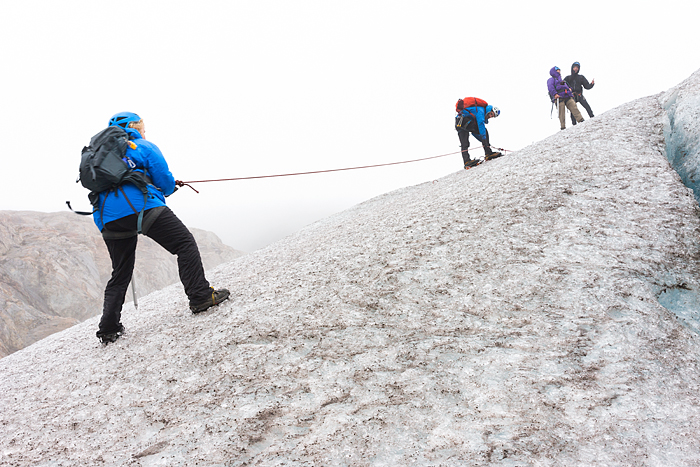 But we all made it down and arrived at the terminus of Lemon Glacier.
But we all made it down and arrived at the terminus of Lemon Glacier.

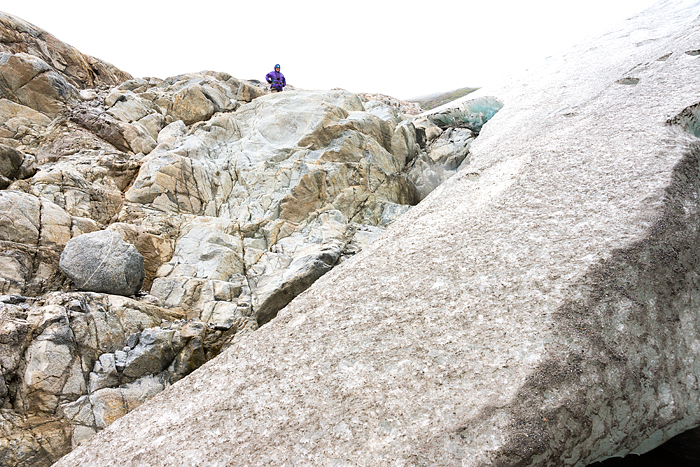
Large boulders accumulated at the terminus base. Note the dirty ice snaking down is almost indistinguishable from the rock. What you miss by not being there in person was the sound of rushing water…hmmm…always a promising sign around a glacier since water creates the most interesting formations…
Exploring the Glacier’s Terminus

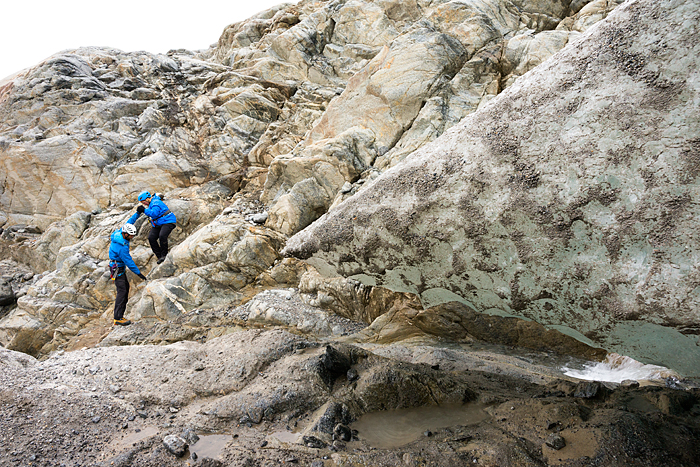
We took off our crampons and scrambled over rocks to explore. Time to find the source of that water!

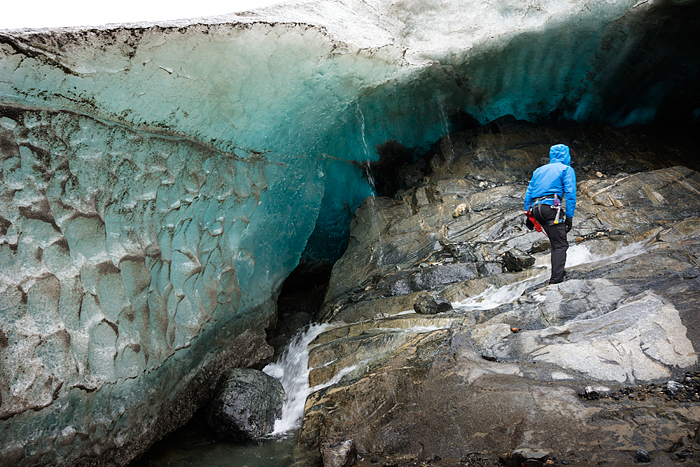
We followed Sam around the foot of the glacier…and discovered a wall with beautiful blue-green ice, melting water and a rushing glacier stream.

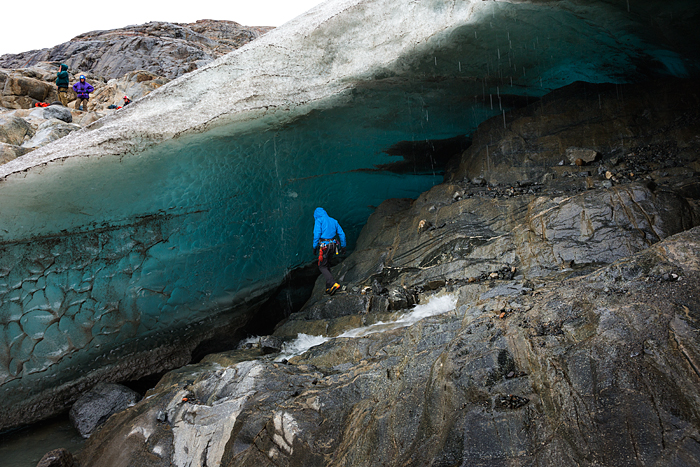
It was pretty incredible to realize that this was the final exit for all the accumulated water that trickled through cracks, tunneled through crevasses, pulsated through moulins and traveled along the bedrock underneath the glacier until it finally escaped—-here.

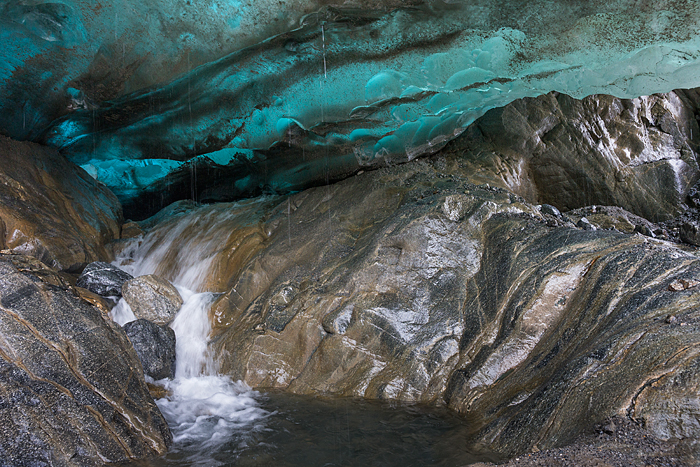
If one could only track the timeline of a single snowflake!

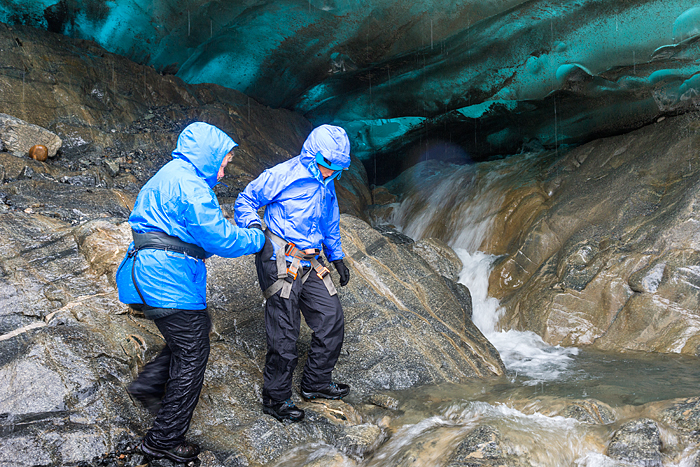
Rain gear? Essential! Leaving the terminus, we climbed back up through rocks to reach the ice.

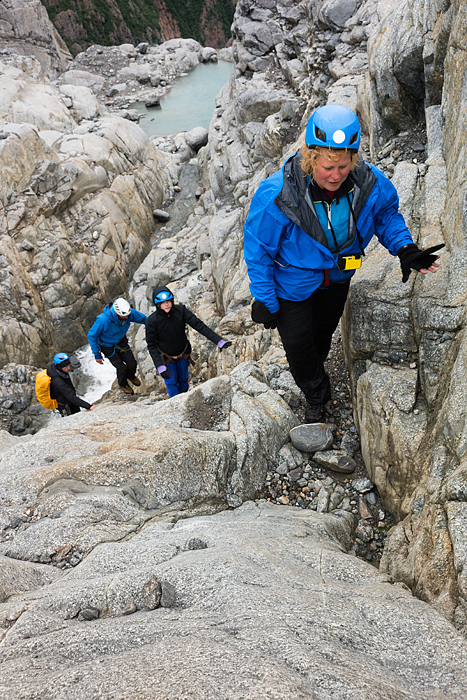
The guides went on ahead to secure the rappelling equipment while we reattached our crampons.

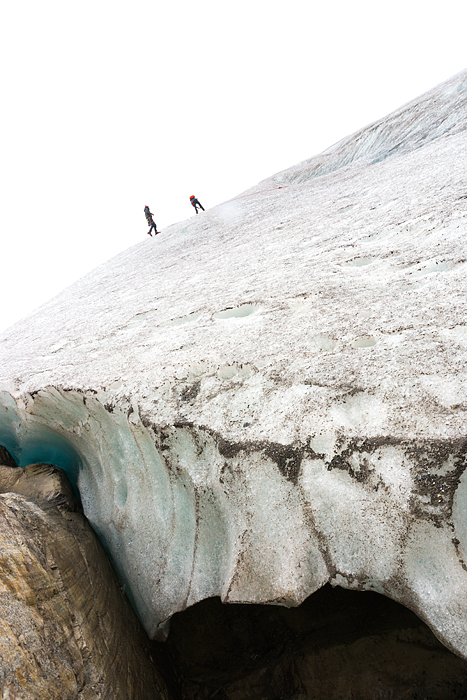
Time to get back on the glacier…These two shots were taken at 24mm and 35mm, not a super wide as you might expect. All photos on day 2 were taken with a single lens, my 24-70mm on a full frame camera.
Climbing Back Up
Going up was much easier than climbing down, but it was comforting to have the security of the rope if we slipped.

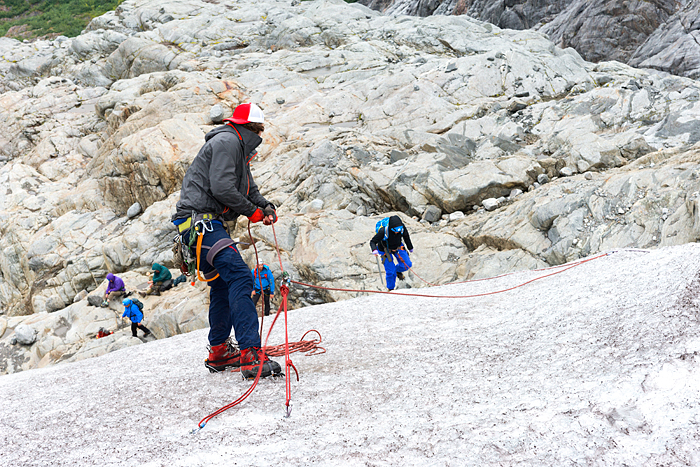
One by one we made it back to the top of Lemon Glacier.

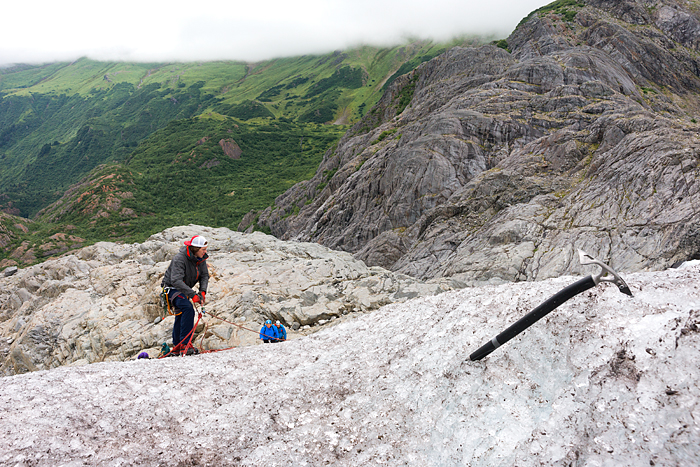

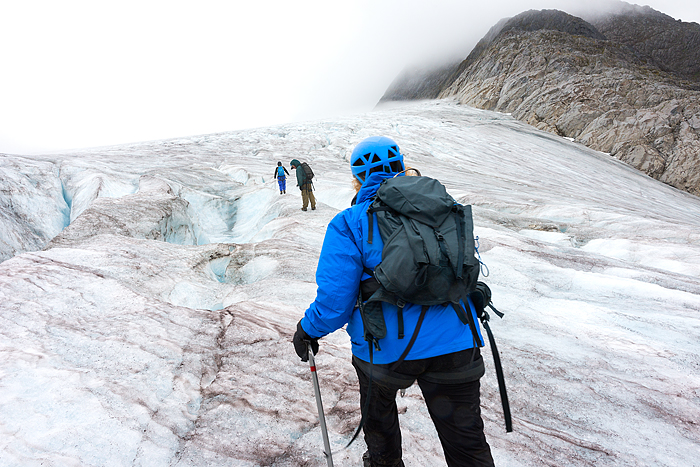
Gorgeous icy landscapes…each depression was filled with wonder and curiosity.



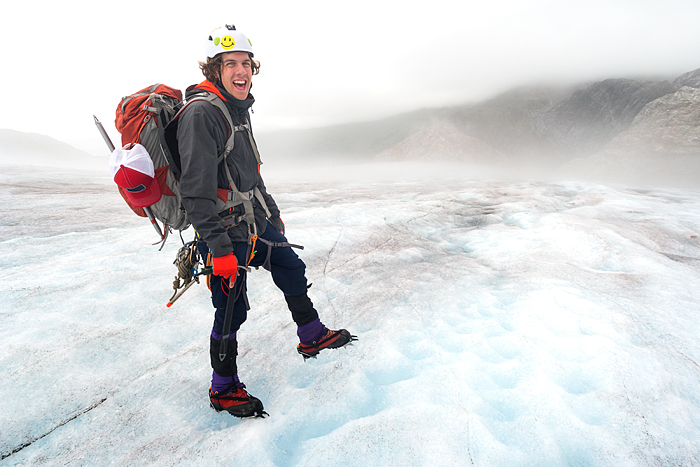
Guides can really make or break an excursion. We were extremely lucky to have such fun-loving, knowledgeable and encouraging guides. Thanks Samuel and Jacob!! And we could tell that they had fun exploring this terrain too 🙂

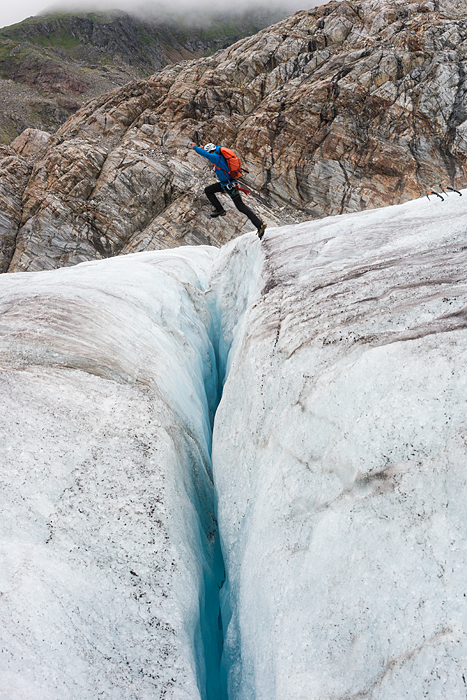
Go, Sam, go!! (No, none of us followed. We just watched!)
Glacial Facial

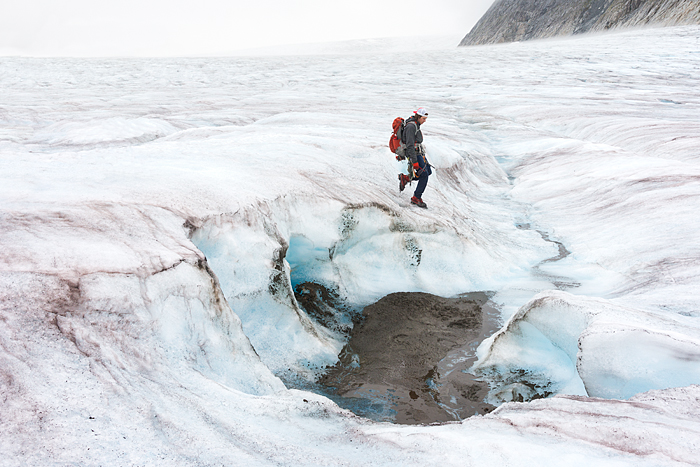
Jacob spotted a mud pit, and came back with mud in his hand. “Anybody want a facial?” he asked. Michelle was game.


Need to refill your water bottle? Easy. Just dip into that icy cold glacial water.

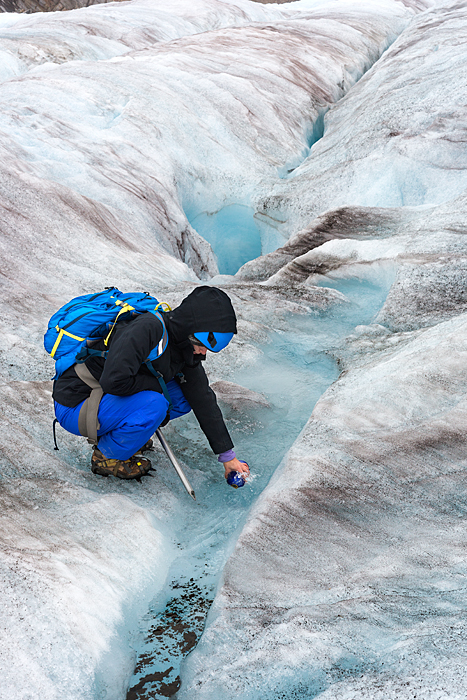
Then Sam decided that was a good place for a polar plunge. Brrrr.

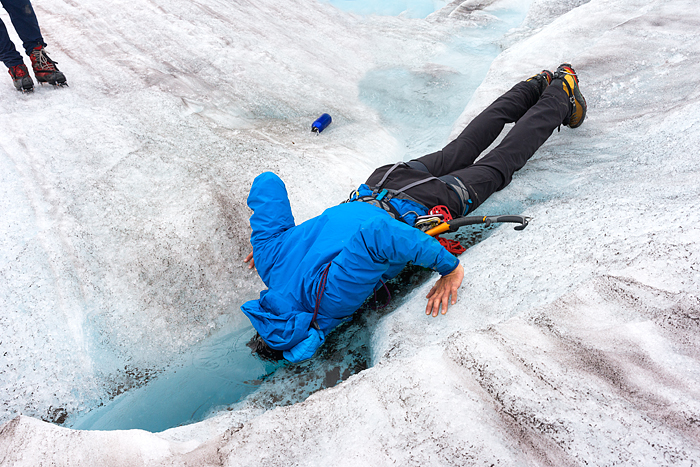
He popped up, shaking icy water from his beard. “Anyone else?” Yep, I shoulda known. My sister, Michelle…

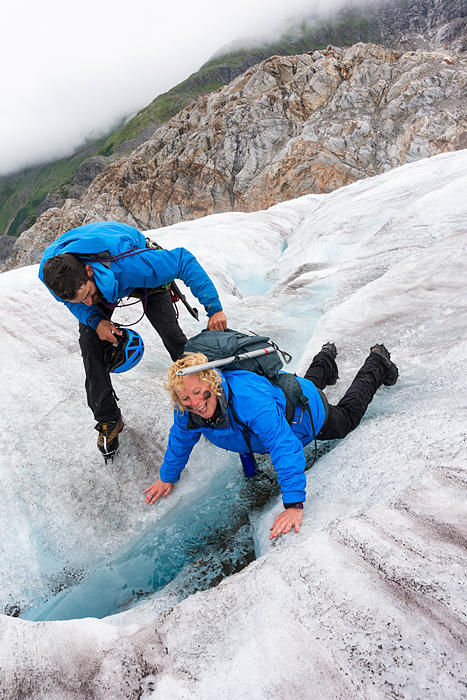
and Connor…twice!

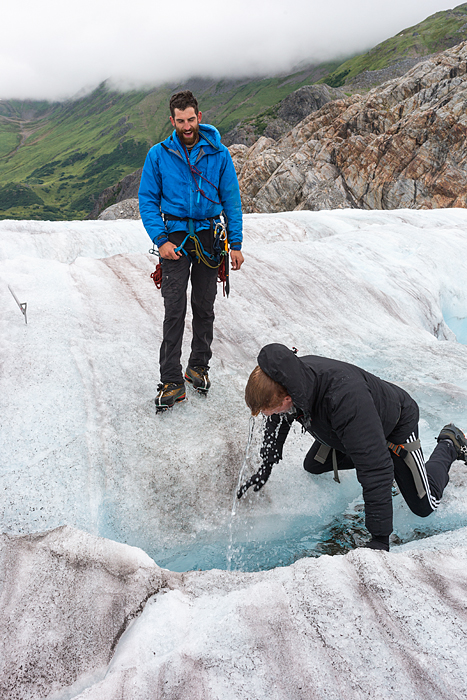
(I think Sam was a little surprised…)

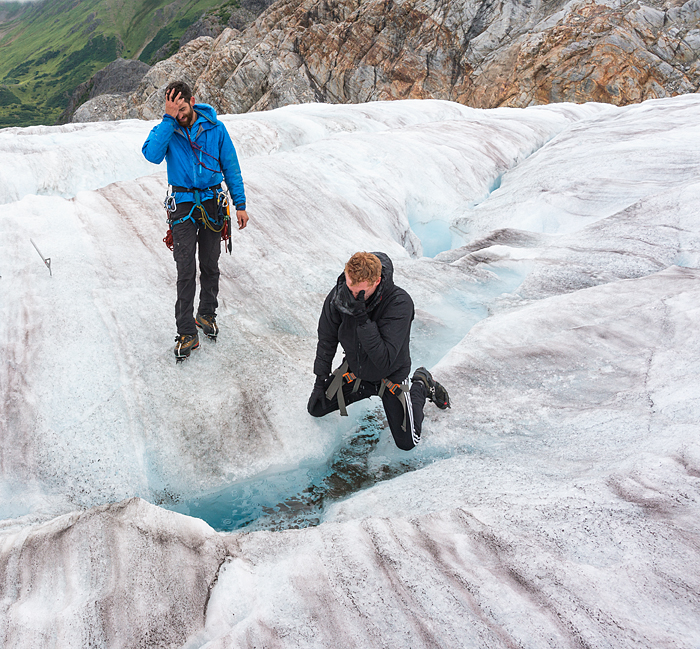
Soon we were back at those incredible crevasses…

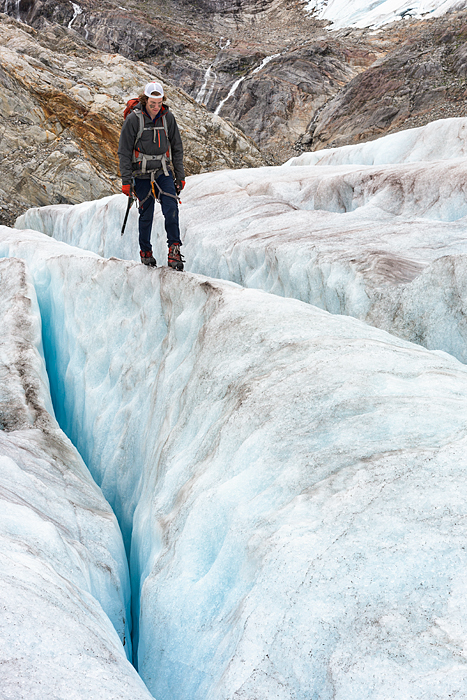
Guides always went first to assess safety.

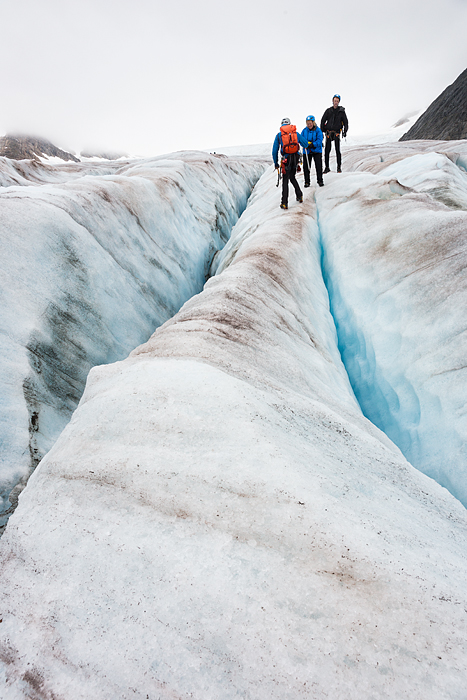
By this time it was getting close to the end of our adventure. Jacob, Pat and John trekked on ahead toward base camp.

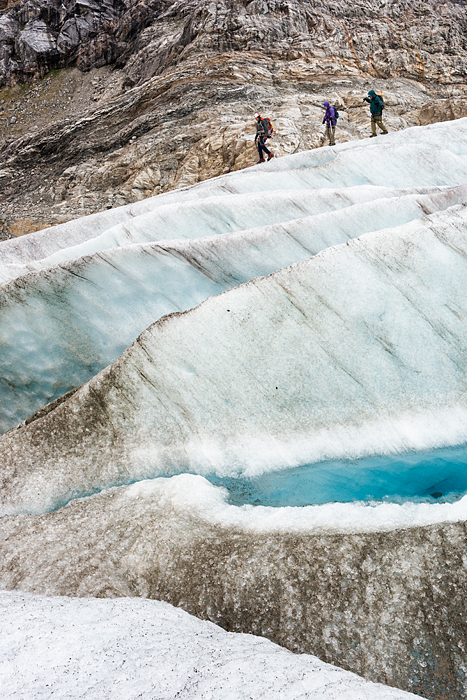
Samuel offered to lead the others on an ice climb. The first action was to rappel down the icy slope.

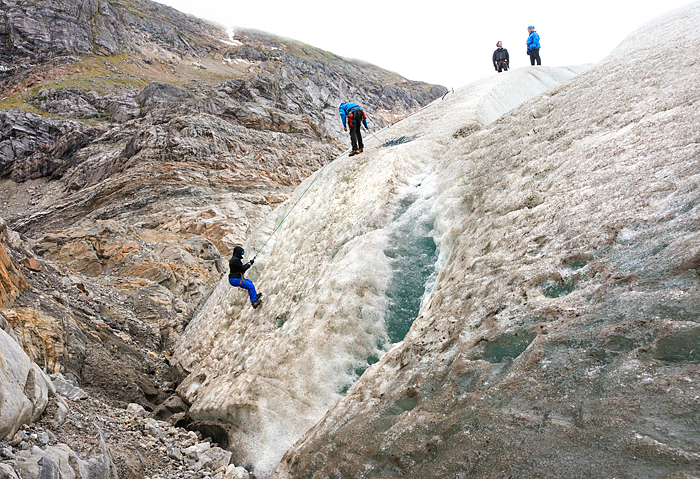
Ice Climbing
Sam instructed us how to climb using the axes. First, plant the axes into the ice (one hand at a time, aiming for dimpled ice is best), then plunge the toes of your boots into the ice (long spikes extend from toe area on crampons) taking 2-4 small steps up. Repeat as you ascend.

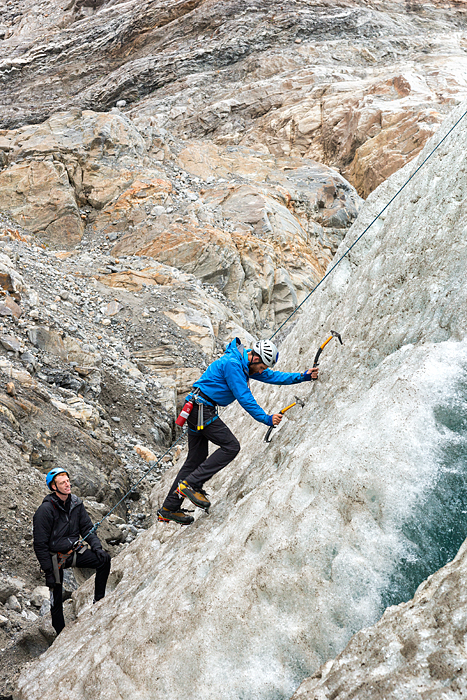
Connor went up in lightning speed.

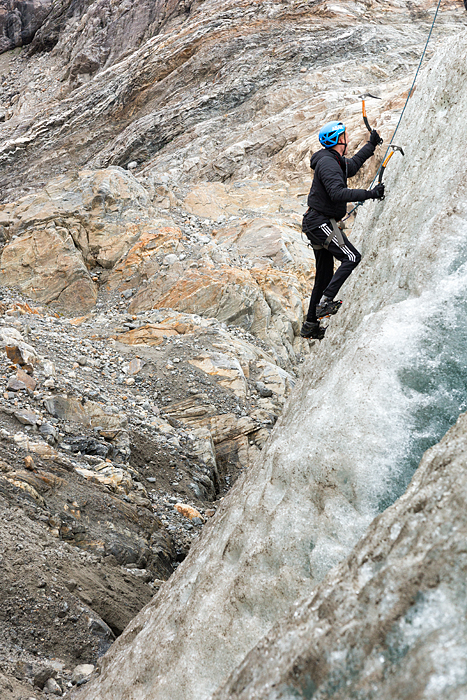
Next…

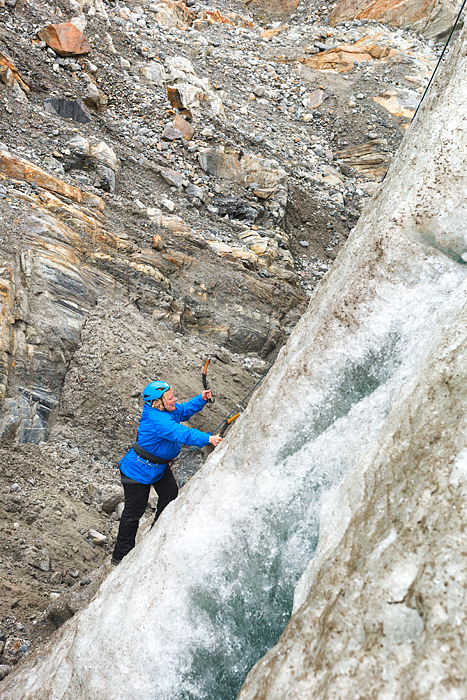
Never one to miss out, my sister ascended despite an injured shoulder, throwing the axes into the ice with all her might.

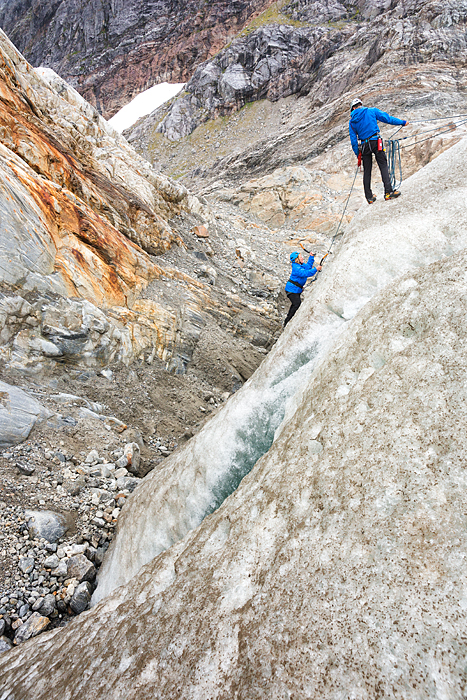
Tah—dah!

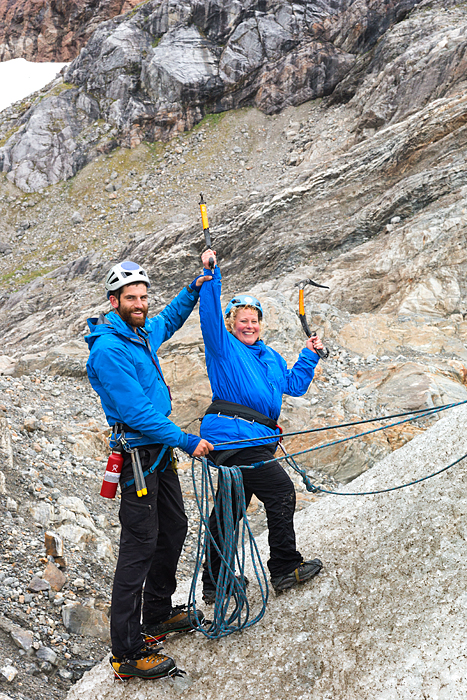
None of us were ready to leave the glacier but we knew that our adventure had come to an end. The opportunity to have 2 days to explore that icy wonderland was nothing short of magical.

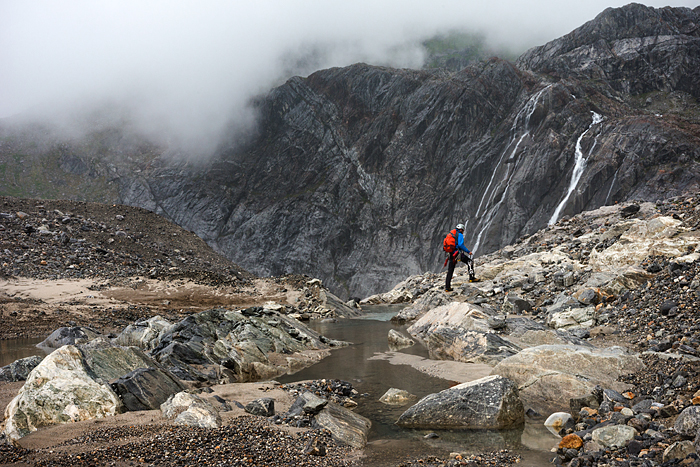
End of our Glacier Trekking Adventure
Heading back through the moraine to base camp, I felt very fortunate that cloudy weather hadn’t prevented us from taking this overnight trekking trip. It was one of those tours that actually surpasses your expectations in every way. And an experience I was thrilled to have shared with my sister.
I would love to come back in a few years and see how the glacier has changed. Where will the terminus be? Alaskan glaciers are receding and disappearing. Most of the features that we saw–ice caves, moulins, crevasses–will naturally melt away by next summer. And new ones will appear. The Juneau Icefield currently has 38 major glaciers and 100 minor ones. But that too is changing…
According to a recent Cambridge study (Journal of Glaciology, Volume 62, February 2016), scientists predict that the glaciers on Juneau’s 1,500-square-mile Ice Field will lose “substantial amounts of mass” during this century and likely completely melt by the next. That’s staggering. Would be a fascinating time to be a scientist studying that field. If I were a high school or college student, I’d jump at the chance to be part of the Juneau Icefield Research Program expedition team that spends 8 weeks exploring and documenting changes on various glaciers. How exciting!

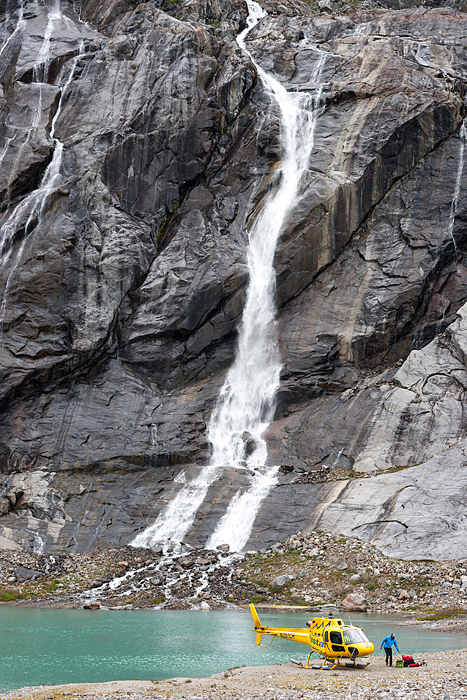
Madam, your carriage awaits…

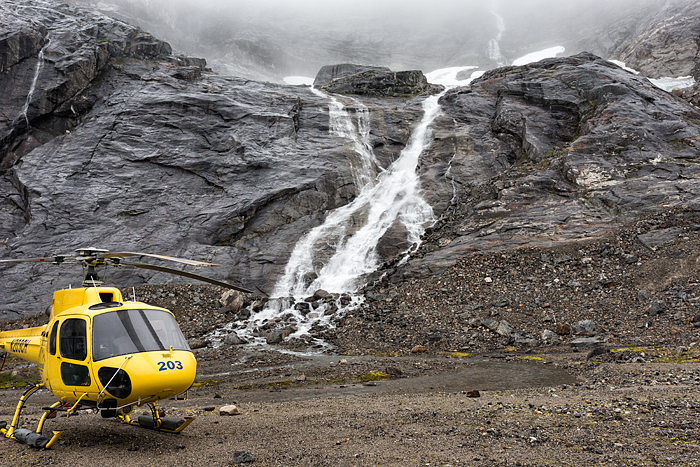
Goodbye Lemon Glacier…thanks for an amazing adventure!

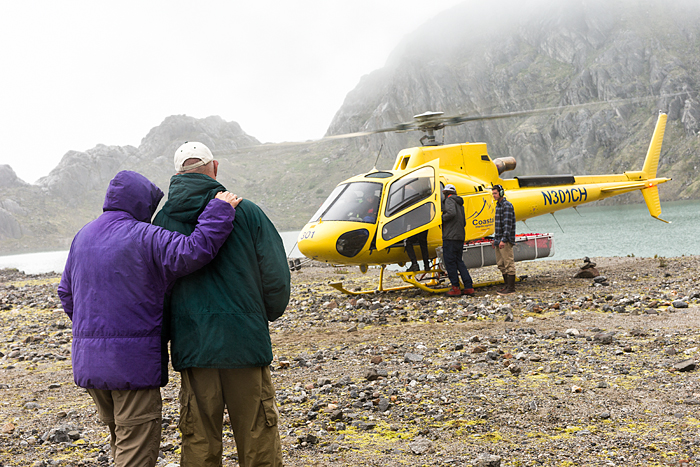
Packing Tips
Essential Clothing/Gear to Bring:
- Waterproof hiking boots (LOVE my Merrell Polarand boots–fleece-lined keeps feet warm and dry, great for fall and spring hiking too)
- Raingear (I love Marmot brand which keeps me dry and comfortable in any season)
- Fleece pullover layers, Fleece leggings, loose fitting hiking pants (my favorite are these fleece-lined Camii hiking pants)
- Knit hat, packable windproof hooded down jacket, gloves, fleece neck warmer
- Headlamp
~~~~~~~~~~~~~~~~~~~~~~~~~~~~~~~~~~~~~~~~~~~~~~~~~~~~~~~~~~~~~~~~~~~~~~~~~~~~~~~~~~~~~~~~~~~~~~~~~~~~~~~~~~~~~~~~~~~~~~~
Wanna come back to this page? Pick your favorite and pin it on your Pinterest board!

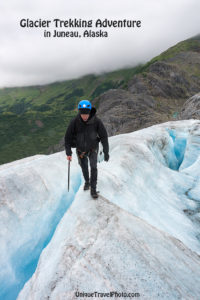


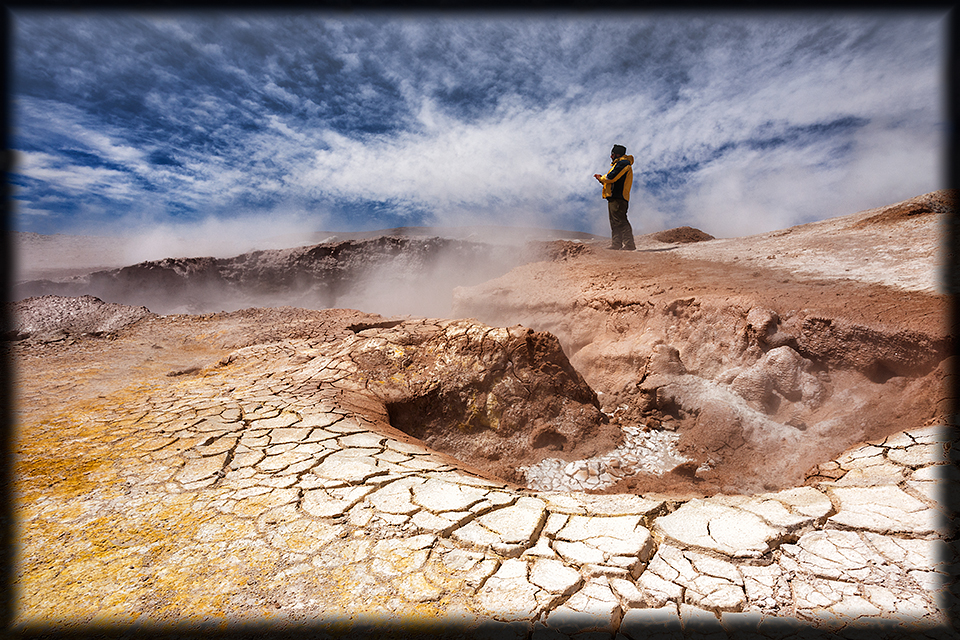
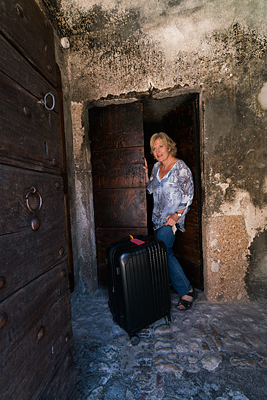
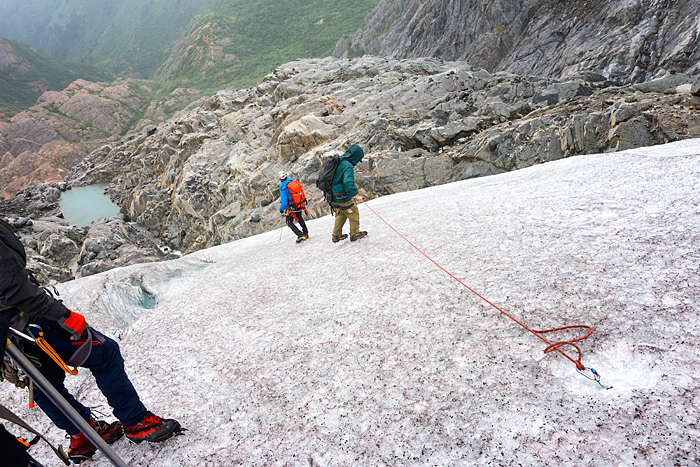
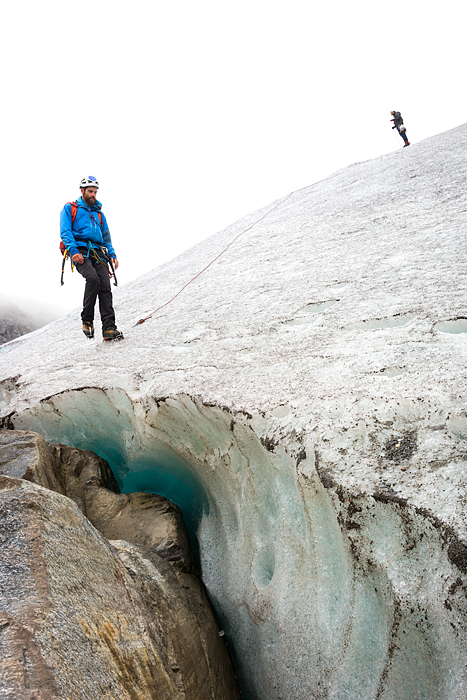
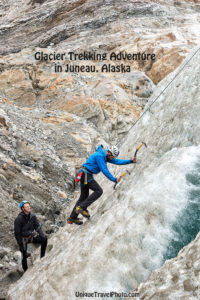
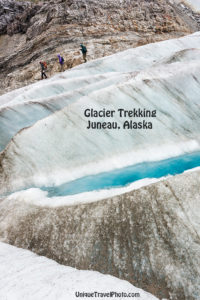
David Miller - Kim,
Your words and photos are fantastic. I can only dream of making a trip like yours. We will be on a cruise in May, but my old body is not made for climbing, jumping, or slipping or sliding.
Thanks for posting.
Dave Miller
admin - I think you might be surprised…you don’t have to climb and jump. As long as you can hike over uneven terrain, the guides are there to help. Will you be cruising through Juneau? ABAK and other companies offer day trips by helicopter up to Mendenhall glacier. If it’s your dream, do it!!!
Pat Warneke - Kim, these pictures are so amazing and so beautiful. They take me right back. The real beauty of them is that I can see the broader picture this time without worrying about sticking my crampons into the ice securely. I would love to purchase the one of John , myself and Jacob heading back to basecamp while the rest of you went with Sam for the ice climb! Let me know how to do that please!
admin - Hi Pat, Yes I agree—it is nice to step back and see the trip as a whole and really appreciate the beauty of where we were and the power of those intriguing moulins! What a fantastic experience it was, and such fun company 🙂 (sending you a private message about purchasing a print)
JaNeal Smith - Kim, these are absolutely unbelievable photos. YOU ARE ABSOLUTELY AN AMAZING PHOTOGRAPHER. PERFECT!!!.
Kim - I think anyone could take amazing photographs here. Lemon Glacier was truly special both on top of and inside the ice! And how incredible to think it starts with a single snowflake…